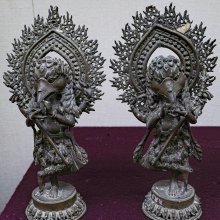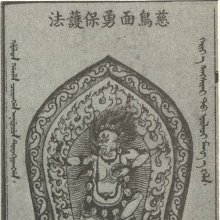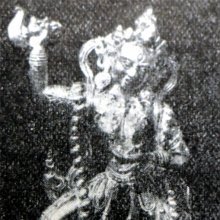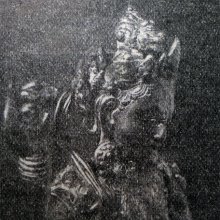Kakasya, Kākāsyā, Kākāsya, Kaka-asya: 6 definitions
Introduction:
Kakasya means something in Buddhism, Pali, Hinduism, Sanskrit. If you want to know the exact meaning, history, etymology or English translation of this term then check out the descriptions on this page. Add your comment or reference to a book if you want to contribute to this summary article.
Images (photo gallery)
In Buddhism
Tibetan Buddhism (Vajrayana or tantric Buddhism)
Source: archive.org: The Indian Buddhist IconographyKākāsyā (काकास्या) (“crow-faced”) refers to one of the eight “Animal-faced Goddess”, as commonly depicted in Buddhist Iconography, and mentioned in the 11th-century Niṣpannayogāvalī of Mahāpaṇḍita Abhayākara.—There is a set of four deities described in the Niṣpannayogāvalī; they all have animal faces and have several forms. They are given each a different direction in the maṇḍala. [...] To this number, in the kālacakra-maṇḍala, four more deities [viz., Kākāsyā] with birds faces are added for the intermediate corners.
Source: Wisdomlib Libary: VajrayoginiKākāsyā (काकास्या, “crow-faced”) is the presiding deity of the eastern outern gate of the vārāhyabhyudaya-maṇḍala, according to the Vārāhyabhyudayatantra (largerly extracted from the 10th century Abhidhānottaratantra). It is composed of the Sanskrit words kāka (crow) and āsya (face). The central deity of the vārāhyabhyudaya-maṇḍala is the twelve-armed Vajravarāhī, which is modeled upon the twelve-armed Cakrasaṃvara, thus inhibiting many similar iconographical features.
Kākāsyā is associated with the colors black and red. She is to be visualised as dwarfish in shape and squint-eyed. They wield in their left hands a skull bowl and the head of Brahmā, and in their right hands a chopper and ḍamaru.
Source: academia.edu: The Structure and Meanings of the Heruka MaṇḍalaKākāsyā (काकास्या) refers to the Ḍākinī of the eastern gate situated in the Guṇacakra, according to the 10th century Ḍākārṇava chapter 15. Accordingly, the guṇacakra refers to one of the four divisions of the sahaja-puṭa (‘innate layer’), situated within the padma (lotus) in the middle of the Herukamaṇḍala. The four gate Ḍākinīs [viz., Kākāsyā] each has the same physical feature as the four Ḍākinīs starting with Lāmā.
Source: OSU Press: Cakrasamvara SamadhiKākāśyā (काकाश्या) is the Eastern Ḍākinī representing one of the four “guardians of the gates” of the Cakrasaṃvara-maṇḍala or Saṃvaramaṇḍala of Abhayākaragupta’s Niṣpannayogāvalī, p. 45 and n. 145; (Cf. Cakrasaṃvaratantra, Gray, David B., 2007).—The Cakrasaṃvara mandala has a total of sixty-two deities. [...] Eight outer Ḍākinīs who make up the guardians of the directional gates and quarters of the cardinal directions.
Kākāśyā is associated with the color “blue” and the Bodhipakṣa (wings of enlightenment) is samyakkarmanta (right action).

Tibetan Buddhism includes schools such as Nyingma, Kadampa, Kagyu and Gelug. Their primary canon of literature is divided in two broad categories: The Kangyur, which consists of Buddha’s words, and the Tengyur, which includes commentaries from various sources. Esotericism and tantra techniques (vajrayāna) are collected indepently.
Languages of India and abroad
Sanskrit dictionary
Source: Cologne Digital Sanskrit Dictionaries: Monier-Williams Sanskrit-English DictionaryKākāsyā (काकास्या):—[from kāka] f. ‘crow-faced’, Name of a Buddhist goddess, [Buddhist literature]
[Sanskrit to German]
Sanskrit, also spelled संस्कृतम् (saṃskṛtam), is an ancient language of India commonly seen as the grandmother of the Indo-European language family (even English!). Closely allied with Prakrit and Pali, Sanskrit is more exhaustive in both grammar and terms and has the most extensive collection of literature in the world, greatly surpassing its sister-languages Greek and Latin.
See also (Relevant definitions)
Starts with: Kakasyaka.
Full-text: Krishna, Pita, Rakta, Shyama, Vajrodbava, Vajrabandha, Purvadi.
Relevant text
Search found 1 books and stories containing Kakasya, Kaka-asya, Kāka-asyā, Kāka-asya, Kākāsyā, Kākāsya; (plurals include: Kakasyas, asyas, asyās, Kākāsyās, Kākāsyas). You can also click to the full overview containing English textual excerpts. Below are direct links for the most relevant articles:
The Indian Buddhist Iconography (by Benoytosh Bhattachacharyya)
Related products



